BSBRES801 Applied Research Report: Strategic Practices
VerifiedAdded on 2022/08/17
|22
|4490
|14
Report
AI Summary
This report, prepared for a management course, explores the multifaceted aspects of applied research. It begins by examining communication processes and methods for effective information exchange within organizations, followed by a discussion of various data collection and analysis techniques, including qualitative, quantitative, and mixed methods approaches. The report emphasizes the importance of adhering to legal requirements, policies, and ethical guidelines in research, covering data privacy, security, and ethical standards. It then delves into presentation techniques and standard reporting methods, providing insights into effective communication of research findings. The report further outlines applied research tools and methods, strategic practices of organizations, and the development of research proposals, including research questions, hypotheses, and the identification of valid populations. It also addresses data limitations, the design of applied research projects, and the documentation and presentation of research findings. The report highlights the significance of strategic planning, policies, and procedures related to research, and concludes by discussing the importance of ethics and confidentiality in research.
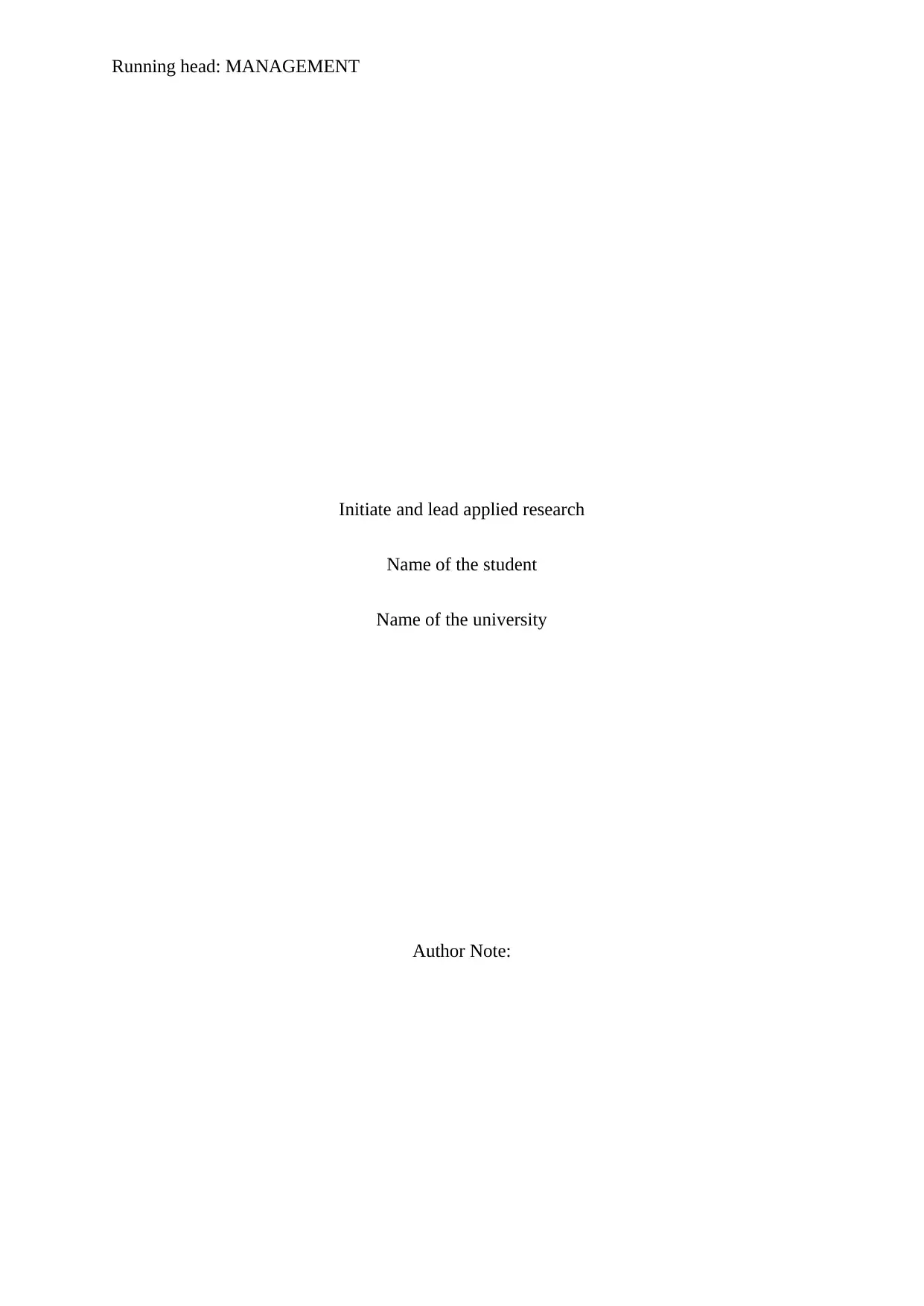
Running head: MANAGEMENT
Initiate and lead applied research
Name of the student
Name of the university
Author Note:
Initiate and lead applied research
Name of the student
Name of the university
Author Note:
Paraphrase This Document
Need a fresh take? Get an instant paraphrase of this document with our AI Paraphraser
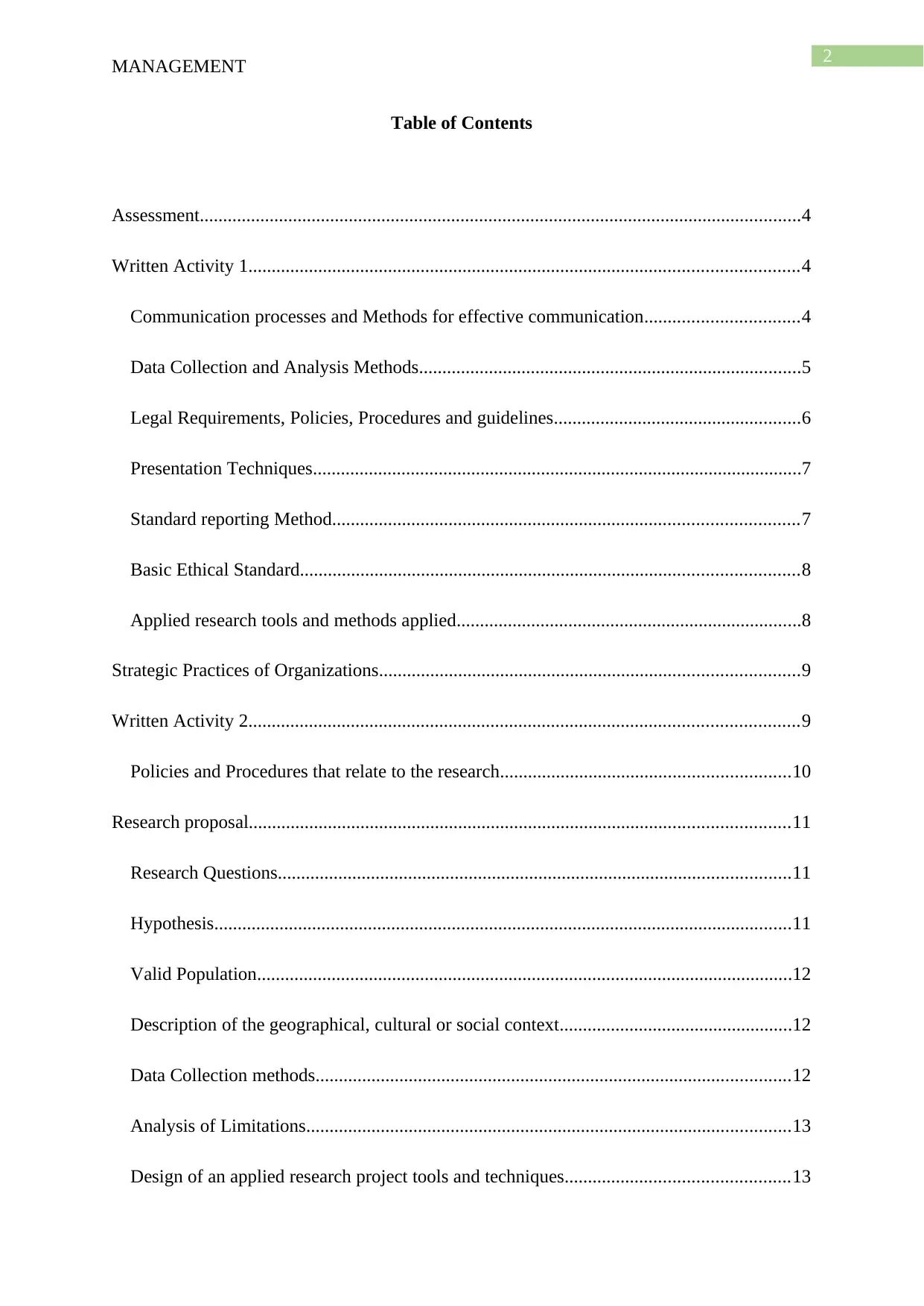
2
MANAGEMENT
Table of Contents
Assessment.................................................................................................................................4
Written Activity 1......................................................................................................................4
Communication processes and Methods for effective communication.................................4
Data Collection and Analysis Methods..................................................................................5
Legal Requirements, Policies, Procedures and guidelines.....................................................6
Presentation Techniques.........................................................................................................7
Standard reporting Method....................................................................................................7
Basic Ethical Standard...........................................................................................................8
Applied research tools and methods applied..........................................................................8
Strategic Practices of Organizations..........................................................................................9
Written Activity 2......................................................................................................................9
Policies and Procedures that relate to the research..............................................................10
Research proposal....................................................................................................................11
Research Questions..............................................................................................................11
Hypothesis............................................................................................................................11
Valid Population...................................................................................................................12
Description of the geographical, cultural or social context..................................................12
Data Collection methods......................................................................................................12
Analysis of Limitations........................................................................................................13
Design of an applied research project tools and techniques................................................13
MANAGEMENT
Table of Contents
Assessment.................................................................................................................................4
Written Activity 1......................................................................................................................4
Communication processes and Methods for effective communication.................................4
Data Collection and Analysis Methods..................................................................................5
Legal Requirements, Policies, Procedures and guidelines.....................................................6
Presentation Techniques.........................................................................................................7
Standard reporting Method....................................................................................................7
Basic Ethical Standard...........................................................................................................8
Applied research tools and methods applied..........................................................................8
Strategic Practices of Organizations..........................................................................................9
Written Activity 2......................................................................................................................9
Policies and Procedures that relate to the research..............................................................10
Research proposal....................................................................................................................11
Research Questions..............................................................................................................11
Hypothesis............................................................................................................................11
Valid Population...................................................................................................................12
Description of the geographical, cultural or social context..................................................12
Data Collection methods......................................................................................................12
Analysis of Limitations........................................................................................................13
Design of an applied research project tools and techniques................................................13
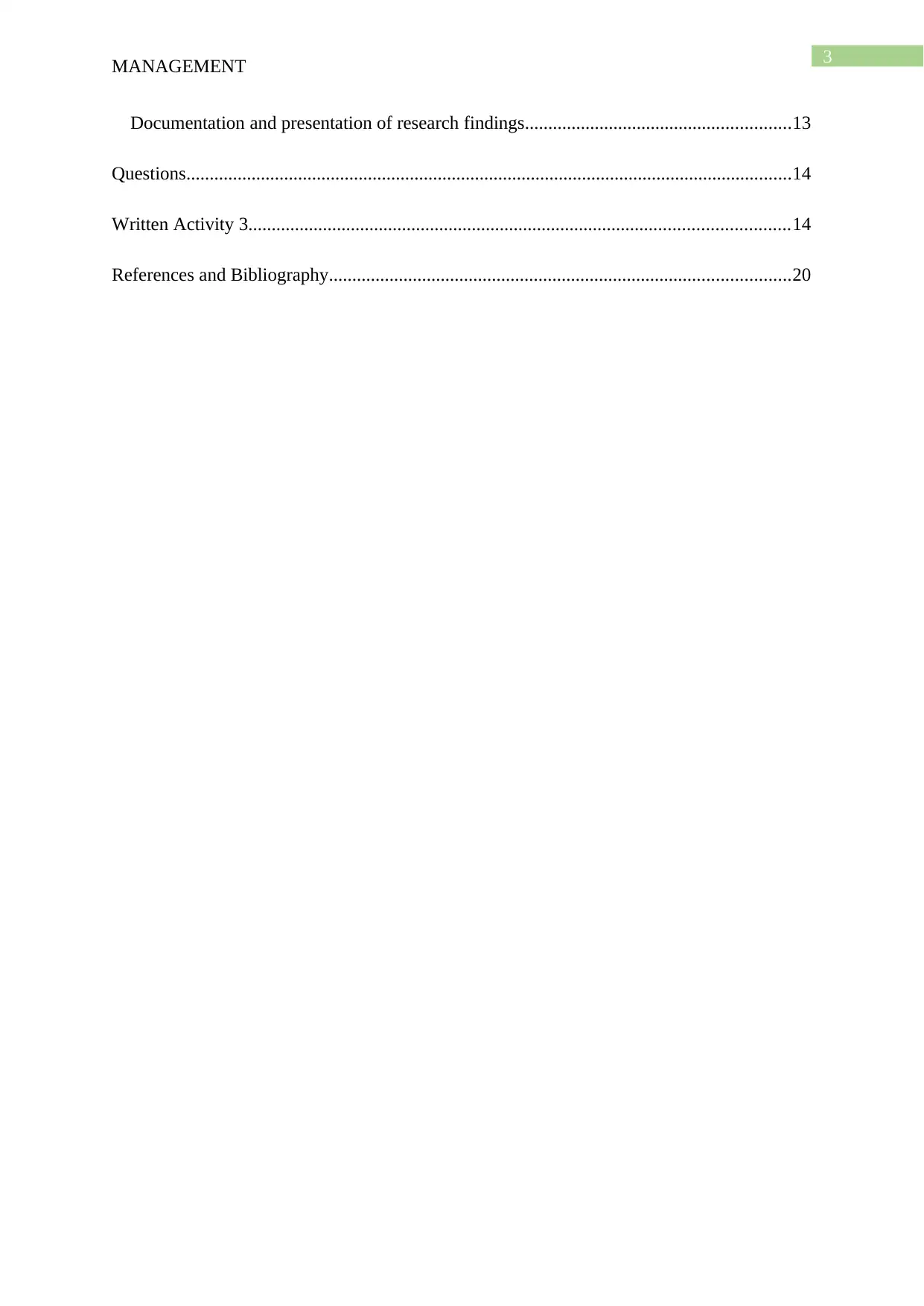
3
MANAGEMENT
Documentation and presentation of research findings.........................................................13
Questions..................................................................................................................................14
Written Activity 3....................................................................................................................14
References and Bibliography...................................................................................................20
MANAGEMENT
Documentation and presentation of research findings.........................................................13
Questions..................................................................................................................................14
Written Activity 3....................................................................................................................14
References and Bibliography...................................................................................................20
⊘ This is a preview!⊘
Do you want full access?
Subscribe today to unlock all pages.

Trusted by 1+ million students worldwide
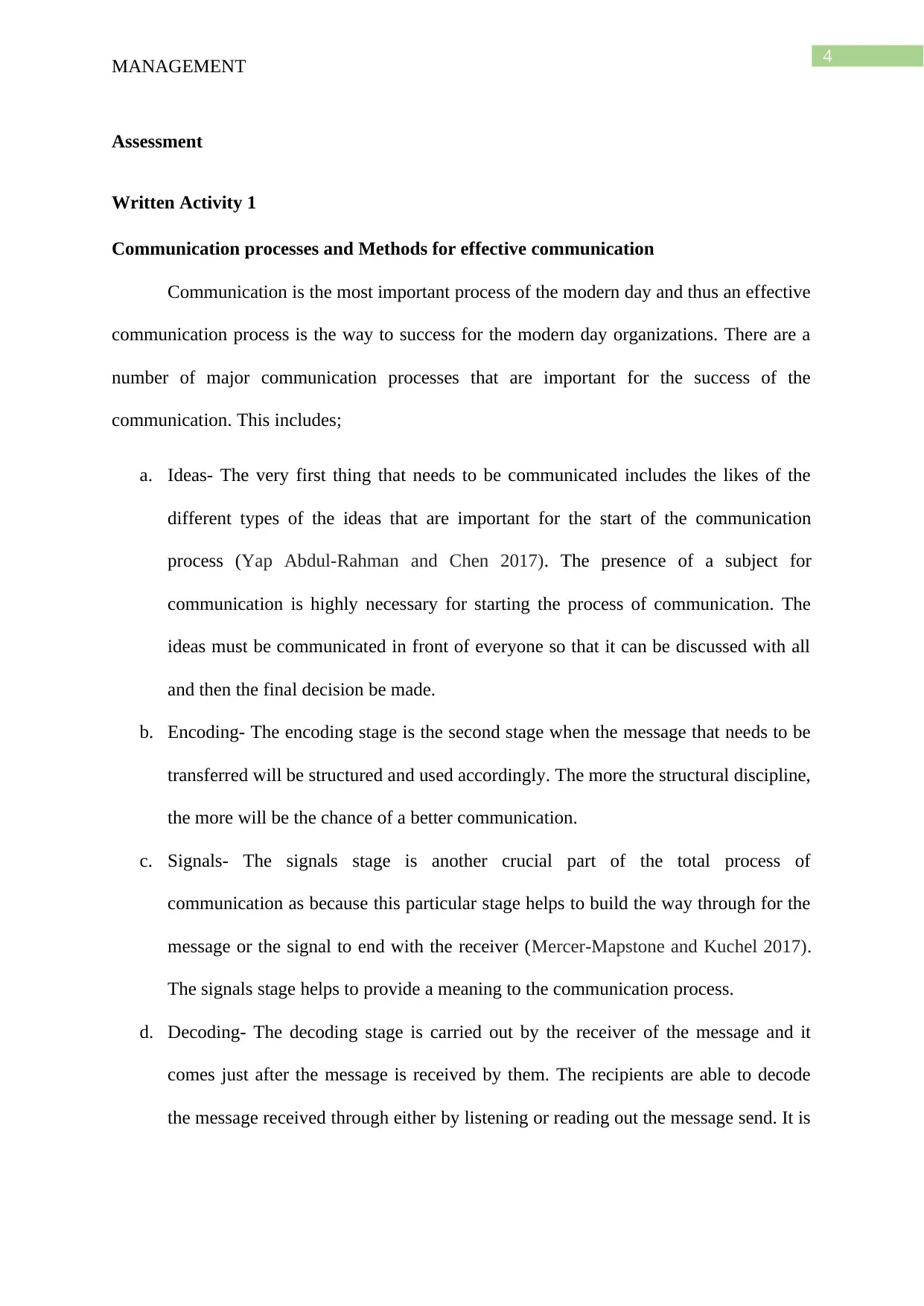
4
MANAGEMENT
Assessment
Written Activity 1
Communication processes and Methods for effective communication
Communication is the most important process of the modern day and thus an effective
communication process is the way to success for the modern day organizations. There are a
number of major communication processes that are important for the success of the
communication. This includes;
a. Ideas- The very first thing that needs to be communicated includes the likes of the
different types of the ideas that are important for the start of the communication
process (Yap Abdul-Rahman and Chen 2017). The presence of a subject for
communication is highly necessary for starting the process of communication. The
ideas must be communicated in front of everyone so that it can be discussed with all
and then the final decision be made.
b. Encoding- The encoding stage is the second stage when the message that needs to be
transferred will be structured and used accordingly. The more the structural discipline,
the more will be the chance of a better communication.
c. Signals- The signals stage is another crucial part of the total process of
communication as because this particular stage helps to build the way through for the
message or the signal to end with the receiver (Mercer-Mapstone and Kuchel 2017).
The signals stage helps to provide a meaning to the communication process.
d. Decoding- The decoding stage is carried out by the receiver of the message and it
comes just after the message is received by them. The recipients are able to decode
the message received through either by listening or reading out the message send. It is
MANAGEMENT
Assessment
Written Activity 1
Communication processes and Methods for effective communication
Communication is the most important process of the modern day and thus an effective
communication process is the way to success for the modern day organizations. There are a
number of major communication processes that are important for the success of the
communication. This includes;
a. Ideas- The very first thing that needs to be communicated includes the likes of the
different types of the ideas that are important for the start of the communication
process (Yap Abdul-Rahman and Chen 2017). The presence of a subject for
communication is highly necessary for starting the process of communication. The
ideas must be communicated in front of everyone so that it can be discussed with all
and then the final decision be made.
b. Encoding- The encoding stage is the second stage when the message that needs to be
transferred will be structured and used accordingly. The more the structural discipline,
the more will be the chance of a better communication.
c. Signals- The signals stage is another crucial part of the total process of
communication as because this particular stage helps to build the way through for the
message or the signal to end with the receiver (Mercer-Mapstone and Kuchel 2017).
The signals stage helps to provide a meaning to the communication process.
d. Decoding- The decoding stage is carried out by the receiver of the message and it
comes just after the message is received by them. The recipients are able to decode
the message received through either by listening or reading out the message send. It is
Paraphrase This Document
Need a fresh take? Get an instant paraphrase of this document with our AI Paraphraser
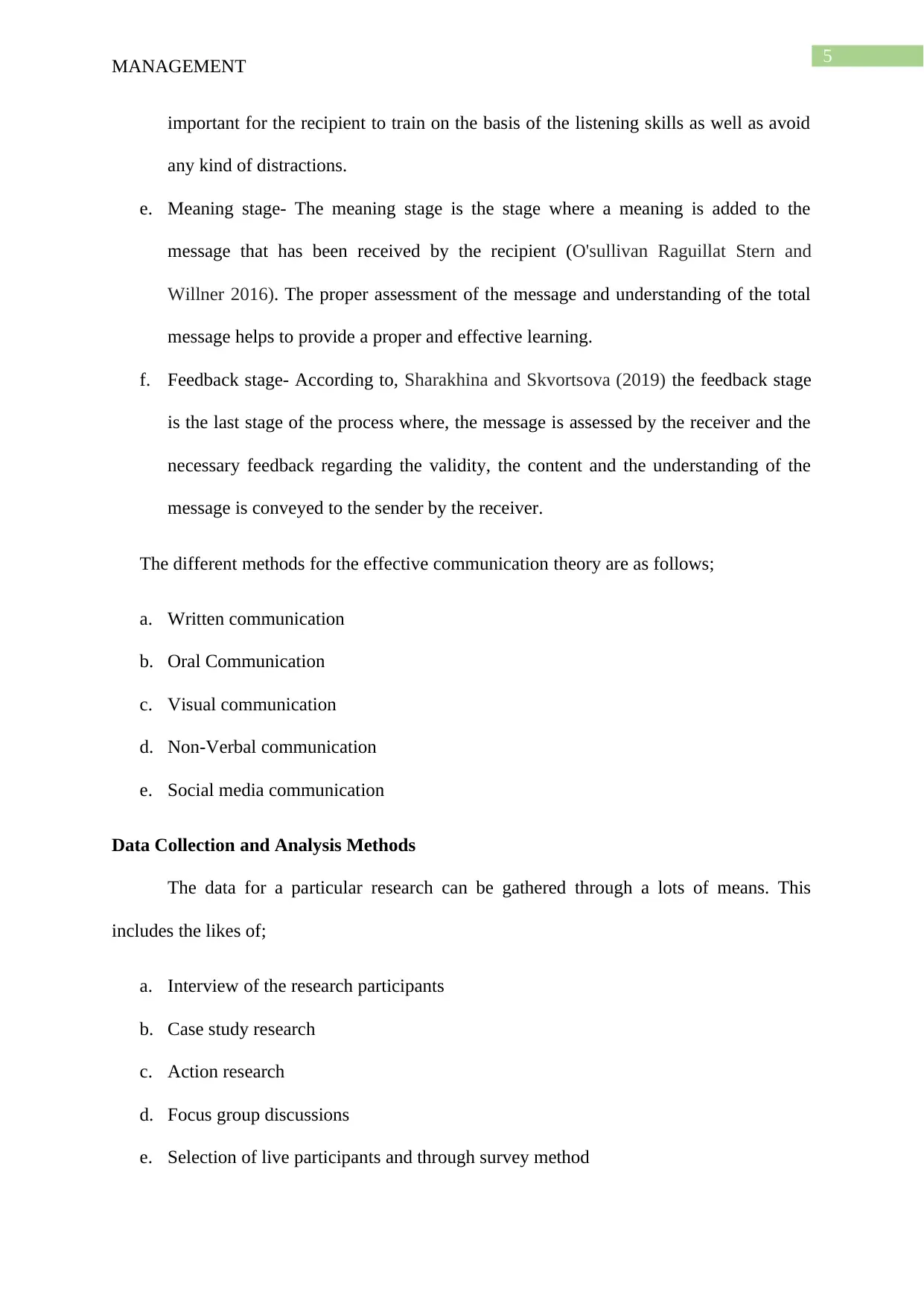
5
MANAGEMENT
important for the recipient to train on the basis of the listening skills as well as avoid
any kind of distractions.
e. Meaning stage- The meaning stage is the stage where a meaning is added to the
message that has been received by the recipient (O'sullivan Raguillat Stern and
Willner 2016). The proper assessment of the message and understanding of the total
message helps to provide a proper and effective learning.
f. Feedback stage- According to, Sharakhina and Skvortsova (2019) the feedback stage
is the last stage of the process where, the message is assessed by the receiver and the
necessary feedback regarding the validity, the content and the understanding of the
message is conveyed to the sender by the receiver.
The different methods for the effective communication theory are as follows;
a. Written communication
b. Oral Communication
c. Visual communication
d. Non-Verbal communication
e. Social media communication
Data Collection and Analysis Methods
The data for a particular research can be gathered through a lots of means. This
includes the likes of;
a. Interview of the research participants
b. Case study research
c. Action research
d. Focus group discussions
e. Selection of live participants and through survey method
MANAGEMENT
important for the recipient to train on the basis of the listening skills as well as avoid
any kind of distractions.
e. Meaning stage- The meaning stage is the stage where a meaning is added to the
message that has been received by the recipient (O'sullivan Raguillat Stern and
Willner 2016). The proper assessment of the message and understanding of the total
message helps to provide a proper and effective learning.
f. Feedback stage- According to, Sharakhina and Skvortsova (2019) the feedback stage
is the last stage of the process where, the message is assessed by the receiver and the
necessary feedback regarding the validity, the content and the understanding of the
message is conveyed to the sender by the receiver.
The different methods for the effective communication theory are as follows;
a. Written communication
b. Oral Communication
c. Visual communication
d. Non-Verbal communication
e. Social media communication
Data Collection and Analysis Methods
The data for a particular research can be gathered through a lots of means. This
includes the likes of;
a. Interview of the research participants
b. Case study research
c. Action research
d. Focus group discussions
e. Selection of live participants and through survey method
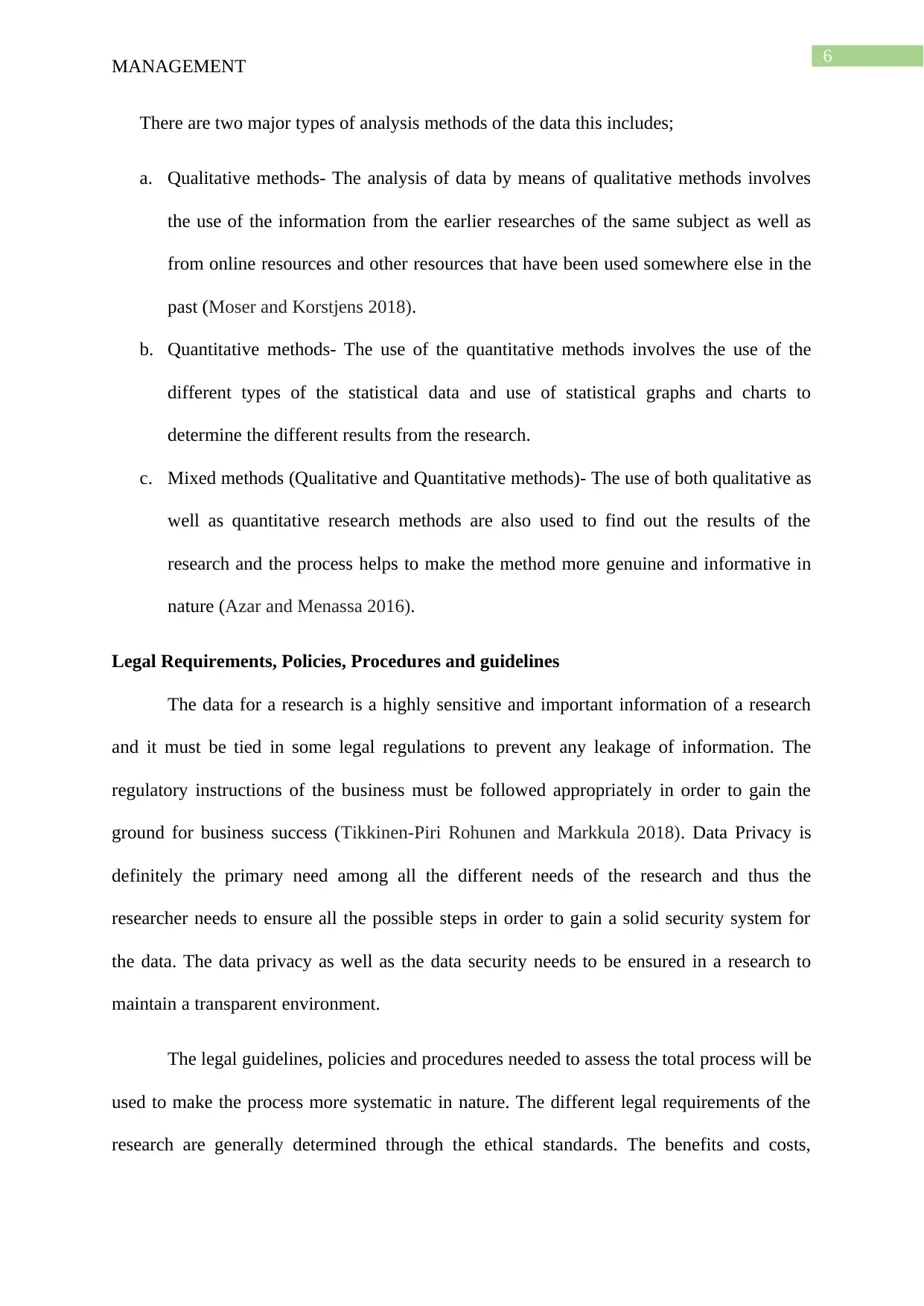
6
MANAGEMENT
There are two major types of analysis methods of the data this includes;
a. Qualitative methods- The analysis of data by means of qualitative methods involves
the use of the information from the earlier researches of the same subject as well as
from online resources and other resources that have been used somewhere else in the
past (Moser and Korstjens 2018).
b. Quantitative methods- The use of the quantitative methods involves the use of the
different types of the statistical data and use of statistical graphs and charts to
determine the different results from the research.
c. Mixed methods (Qualitative and Quantitative methods)- The use of both qualitative as
well as quantitative research methods are also used to find out the results of the
research and the process helps to make the method more genuine and informative in
nature (Azar and Menassa 2016).
Legal Requirements, Policies, Procedures and guidelines
The data for a research is a highly sensitive and important information of a research
and it must be tied in some legal regulations to prevent any leakage of information. The
regulatory instructions of the business must be followed appropriately in order to gain the
ground for business success (Tikkinen-Piri Rohunen and Markkula 2018). Data Privacy is
definitely the primary need among all the different needs of the research and thus the
researcher needs to ensure all the possible steps in order to gain a solid security system for
the data. The data privacy as well as the data security needs to be ensured in a research to
maintain a transparent environment.
The legal guidelines, policies and procedures needed to assess the total process will be
used to make the process more systematic in nature. The different legal requirements of the
research are generally determined through the ethical standards. The benefits and costs,
MANAGEMENT
There are two major types of analysis methods of the data this includes;
a. Qualitative methods- The analysis of data by means of qualitative methods involves
the use of the information from the earlier researches of the same subject as well as
from online resources and other resources that have been used somewhere else in the
past (Moser and Korstjens 2018).
b. Quantitative methods- The use of the quantitative methods involves the use of the
different types of the statistical data and use of statistical graphs and charts to
determine the different results from the research.
c. Mixed methods (Qualitative and Quantitative methods)- The use of both qualitative as
well as quantitative research methods are also used to find out the results of the
research and the process helps to make the method more genuine and informative in
nature (Azar and Menassa 2016).
Legal Requirements, Policies, Procedures and guidelines
The data for a research is a highly sensitive and important information of a research
and it must be tied in some legal regulations to prevent any leakage of information. The
regulatory instructions of the business must be followed appropriately in order to gain the
ground for business success (Tikkinen-Piri Rohunen and Markkula 2018). Data Privacy is
definitely the primary need among all the different needs of the research and thus the
researcher needs to ensure all the possible steps in order to gain a solid security system for
the data. The data privacy as well as the data security needs to be ensured in a research to
maintain a transparent environment.
The legal guidelines, policies and procedures needed to assess the total process will be
used to make the process more systematic in nature. The different legal requirements of the
research are generally determined through the ethical standards. The benefits and costs,
⊘ This is a preview!⊘
Do you want full access?
Subscribe today to unlock all pages.

Trusted by 1+ million students worldwide
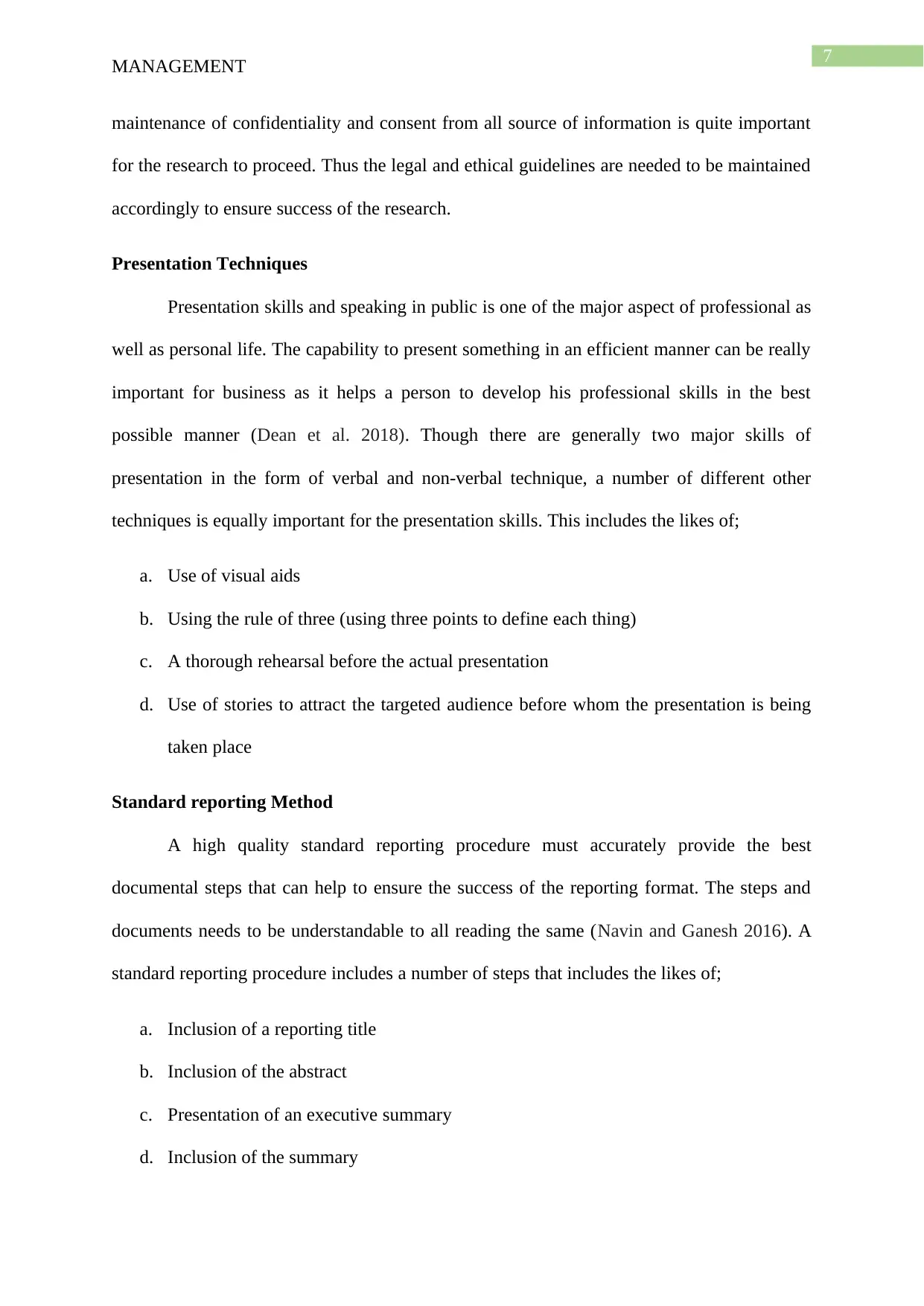
7
MANAGEMENT
maintenance of confidentiality and consent from all source of information is quite important
for the research to proceed. Thus the legal and ethical guidelines are needed to be maintained
accordingly to ensure success of the research.
Presentation Techniques
Presentation skills and speaking in public is one of the major aspect of professional as
well as personal life. The capability to present something in an efficient manner can be really
important for business as it helps a person to develop his professional skills in the best
possible manner (Dean et al. 2018). Though there are generally two major skills of
presentation in the form of verbal and non-verbal technique, a number of different other
techniques is equally important for the presentation skills. This includes the likes of;
a. Use of visual aids
b. Using the rule of three (using three points to define each thing)
c. A thorough rehearsal before the actual presentation
d. Use of stories to attract the targeted audience before whom the presentation is being
taken place
Standard reporting Method
A high quality standard reporting procedure must accurately provide the best
documental steps that can help to ensure the success of the reporting format. The steps and
documents needs to be understandable to all reading the same (Navin and Ganesh 2016). A
standard reporting procedure includes a number of steps that includes the likes of;
a. Inclusion of a reporting title
b. Inclusion of the abstract
c. Presentation of an executive summary
d. Inclusion of the summary
MANAGEMENT
maintenance of confidentiality and consent from all source of information is quite important
for the research to proceed. Thus the legal and ethical guidelines are needed to be maintained
accordingly to ensure success of the research.
Presentation Techniques
Presentation skills and speaking in public is one of the major aspect of professional as
well as personal life. The capability to present something in an efficient manner can be really
important for business as it helps a person to develop his professional skills in the best
possible manner (Dean et al. 2018). Though there are generally two major skills of
presentation in the form of verbal and non-verbal technique, a number of different other
techniques is equally important for the presentation skills. This includes the likes of;
a. Use of visual aids
b. Using the rule of three (using three points to define each thing)
c. A thorough rehearsal before the actual presentation
d. Use of stories to attract the targeted audience before whom the presentation is being
taken place
Standard reporting Method
A high quality standard reporting procedure must accurately provide the best
documental steps that can help to ensure the success of the reporting format. The steps and
documents needs to be understandable to all reading the same (Navin and Ganesh 2016). A
standard reporting procedure includes a number of steps that includes the likes of;
a. Inclusion of a reporting title
b. Inclusion of the abstract
c. Presentation of an executive summary
d. Inclusion of the summary
Paraphrase This Document
Need a fresh take? Get an instant paraphrase of this document with our AI Paraphraser
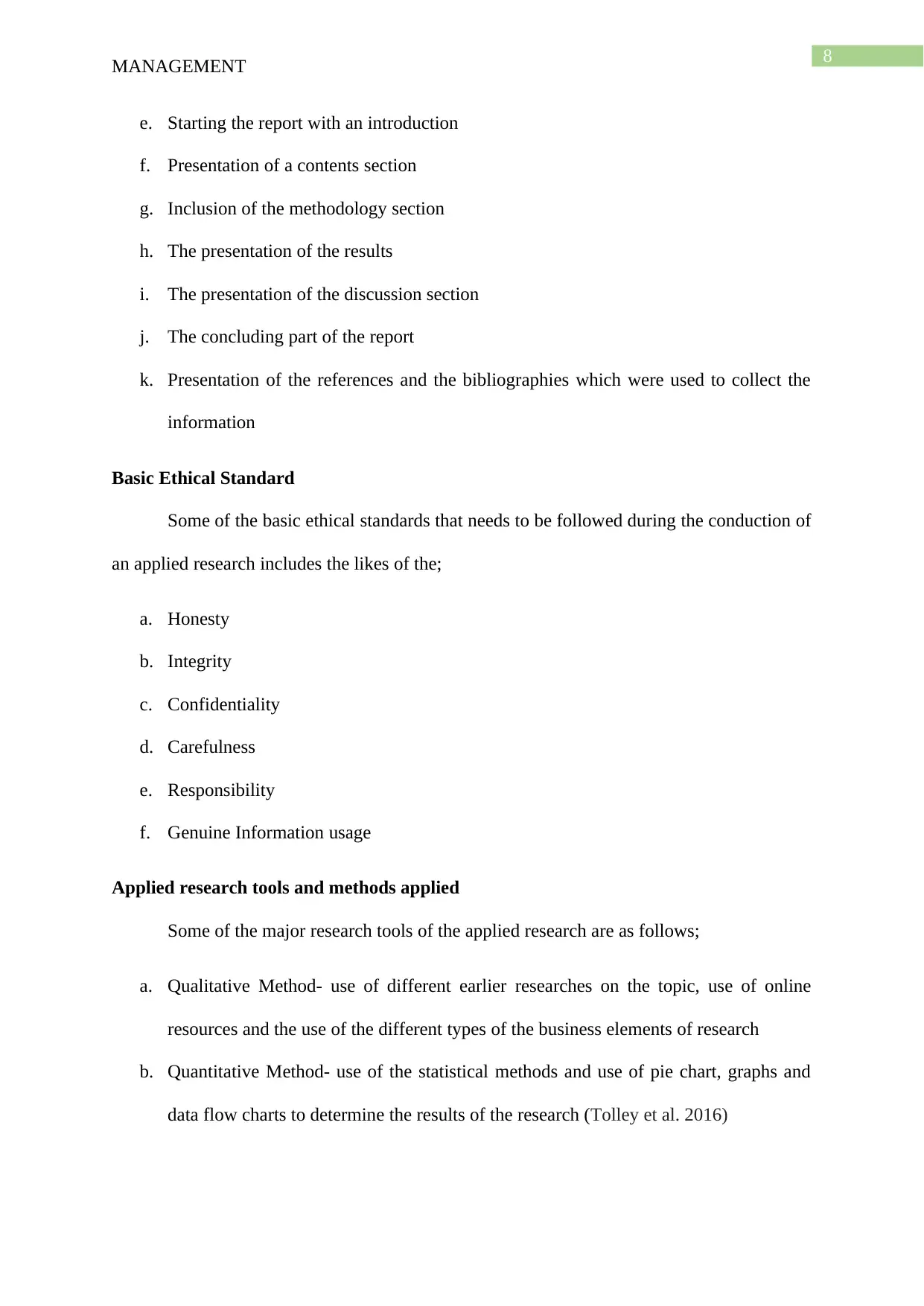
8
MANAGEMENT
e. Starting the report with an introduction
f. Presentation of a contents section
g. Inclusion of the methodology section
h. The presentation of the results
i. The presentation of the discussion section
j. The concluding part of the report
k. Presentation of the references and the bibliographies which were used to collect the
information
Basic Ethical Standard
Some of the basic ethical standards that needs to be followed during the conduction of
an applied research includes the likes of the;
a. Honesty
b. Integrity
c. Confidentiality
d. Carefulness
e. Responsibility
f. Genuine Information usage
Applied research tools and methods applied
Some of the major research tools of the applied research are as follows;
a. Qualitative Method- use of different earlier researches on the topic, use of online
resources and the use of the different types of the business elements of research
b. Quantitative Method- use of the statistical methods and use of pie chart, graphs and
data flow charts to determine the results of the research (Tolley et al. 2016)
MANAGEMENT
e. Starting the report with an introduction
f. Presentation of a contents section
g. Inclusion of the methodology section
h. The presentation of the results
i. The presentation of the discussion section
j. The concluding part of the report
k. Presentation of the references and the bibliographies which were used to collect the
information
Basic Ethical Standard
Some of the basic ethical standards that needs to be followed during the conduction of
an applied research includes the likes of the;
a. Honesty
b. Integrity
c. Confidentiality
d. Carefulness
e. Responsibility
f. Genuine Information usage
Applied research tools and methods applied
Some of the major research tools of the applied research are as follows;
a. Qualitative Method- use of different earlier researches on the topic, use of online
resources and the use of the different types of the business elements of research
b. Quantitative Method- use of the statistical methods and use of pie chart, graphs and
data flow charts to determine the results of the research (Tolley et al. 2016)
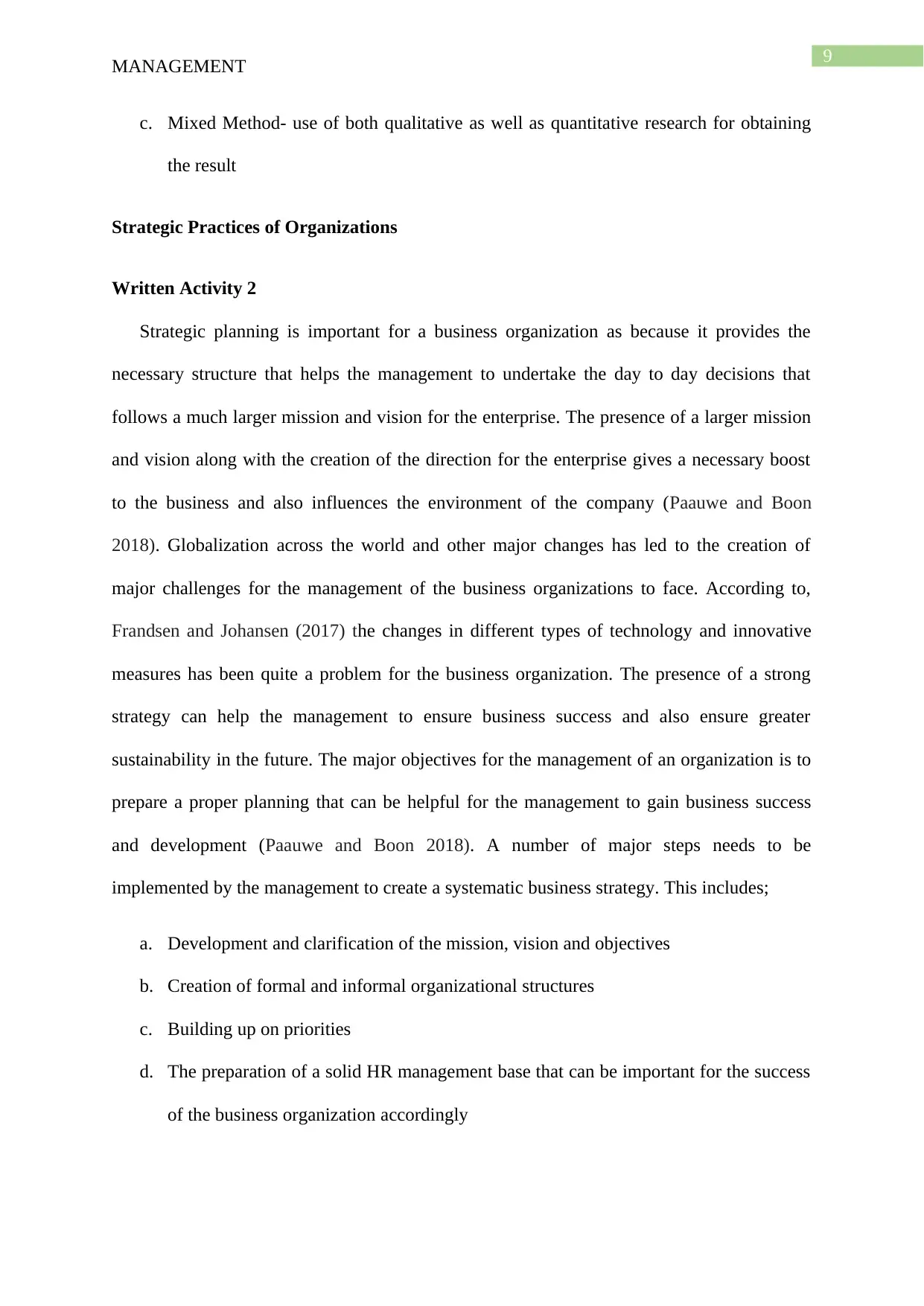
9
MANAGEMENT
c. Mixed Method- use of both qualitative as well as quantitative research for obtaining
the result
Strategic Practices of Organizations
Written Activity 2
Strategic planning is important for a business organization as because it provides the
necessary structure that helps the management to undertake the day to day decisions that
follows a much larger mission and vision for the enterprise. The presence of a larger mission
and vision along with the creation of the direction for the enterprise gives a necessary boost
to the business and also influences the environment of the company (Paauwe and Boon
2018). Globalization across the world and other major changes has led to the creation of
major challenges for the management of the business organizations to face. According to,
Frandsen and Johansen (2017) the changes in different types of technology and innovative
measures has been quite a problem for the business organization. The presence of a strong
strategy can help the management to ensure business success and also ensure greater
sustainability in the future. The major objectives for the management of an organization is to
prepare a proper planning that can be helpful for the management to gain business success
and development (Paauwe and Boon 2018). A number of major steps needs to be
implemented by the management to create a systematic business strategy. This includes;
a. Development and clarification of the mission, vision and objectives
b. Creation of formal and informal organizational structures
c. Building up on priorities
d. The preparation of a solid HR management base that can be important for the success
of the business organization accordingly
MANAGEMENT
c. Mixed Method- use of both qualitative as well as quantitative research for obtaining
the result
Strategic Practices of Organizations
Written Activity 2
Strategic planning is important for a business organization as because it provides the
necessary structure that helps the management to undertake the day to day decisions that
follows a much larger mission and vision for the enterprise. The presence of a larger mission
and vision along with the creation of the direction for the enterprise gives a necessary boost
to the business and also influences the environment of the company (Paauwe and Boon
2018). Globalization across the world and other major changes has led to the creation of
major challenges for the management of the business organizations to face. According to,
Frandsen and Johansen (2017) the changes in different types of technology and innovative
measures has been quite a problem for the business organization. The presence of a strong
strategy can help the management to ensure business success and also ensure greater
sustainability in the future. The major objectives for the management of an organization is to
prepare a proper planning that can be helpful for the management to gain business success
and development (Paauwe and Boon 2018). A number of major steps needs to be
implemented by the management to create a systematic business strategy. This includes;
a. Development and clarification of the mission, vision and objectives
b. Creation of formal and informal organizational structures
c. Building up on priorities
d. The preparation of a solid HR management base that can be important for the success
of the business organization accordingly
⊘ This is a preview!⊘
Do you want full access?
Subscribe today to unlock all pages.

Trusted by 1+ million students worldwide
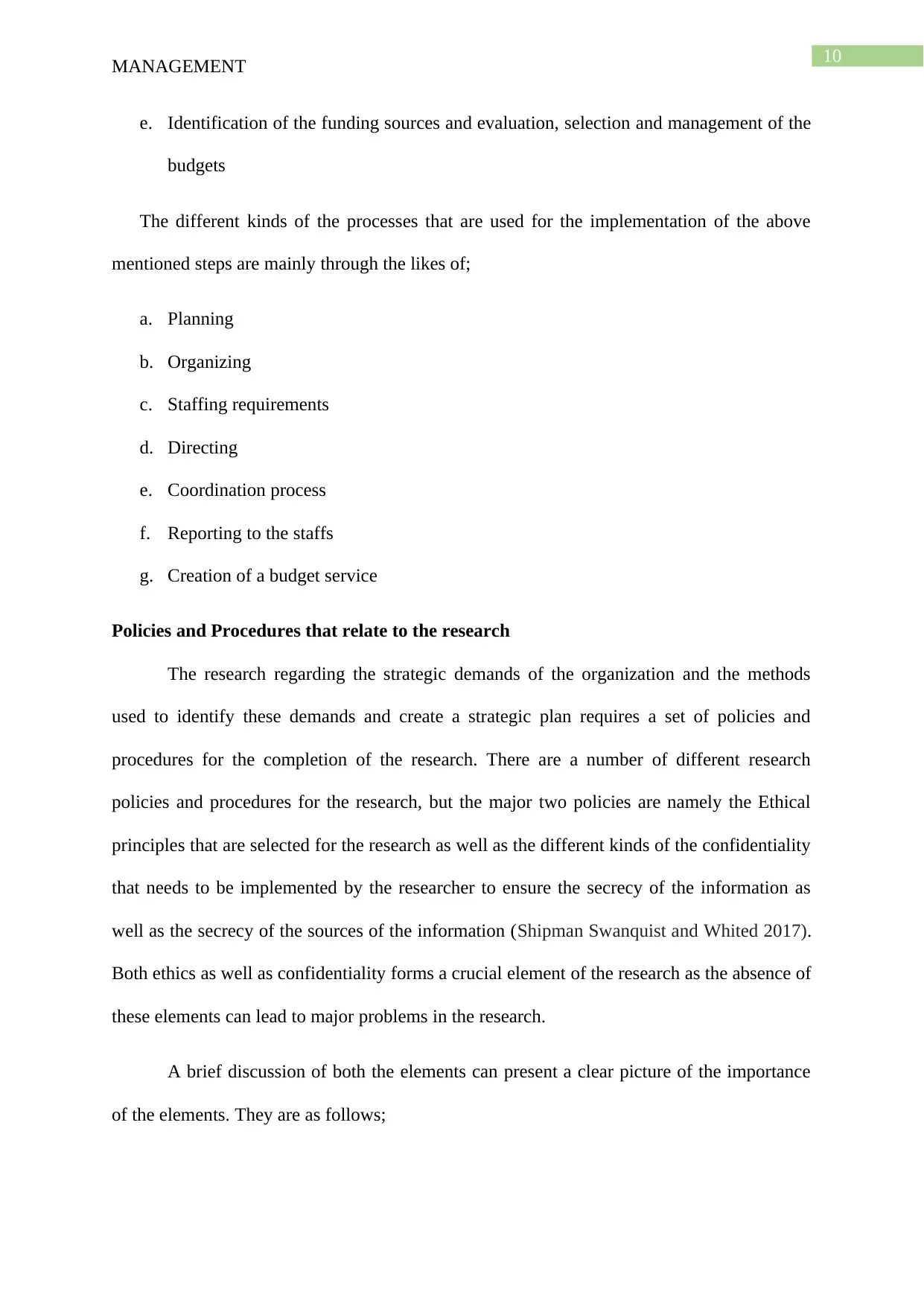
10
MANAGEMENT
e. Identification of the funding sources and evaluation, selection and management of the
budgets
The different kinds of the processes that are used for the implementation of the above
mentioned steps are mainly through the likes of;
a. Planning
b. Organizing
c. Staffing requirements
d. Directing
e. Coordination process
f. Reporting to the staffs
g. Creation of a budget service
Policies and Procedures that relate to the research
The research regarding the strategic demands of the organization and the methods
used to identify these demands and create a strategic plan requires a set of policies and
procedures for the completion of the research. There are a number of different research
policies and procedures for the research, but the major two policies are namely the Ethical
principles that are selected for the research as well as the different kinds of the confidentiality
that needs to be implemented by the researcher to ensure the secrecy of the information as
well as the secrecy of the sources of the information (Shipman Swanquist and Whited 2017).
Both ethics as well as confidentiality forms a crucial element of the research as the absence of
these elements can lead to major problems in the research.
A brief discussion of both the elements can present a clear picture of the importance
of the elements. They are as follows;
MANAGEMENT
e. Identification of the funding sources and evaluation, selection and management of the
budgets
The different kinds of the processes that are used for the implementation of the above
mentioned steps are mainly through the likes of;
a. Planning
b. Organizing
c. Staffing requirements
d. Directing
e. Coordination process
f. Reporting to the staffs
g. Creation of a budget service
Policies and Procedures that relate to the research
The research regarding the strategic demands of the organization and the methods
used to identify these demands and create a strategic plan requires a set of policies and
procedures for the completion of the research. There are a number of different research
policies and procedures for the research, but the major two policies are namely the Ethical
principles that are selected for the research as well as the different kinds of the confidentiality
that needs to be implemented by the researcher to ensure the secrecy of the information as
well as the secrecy of the sources of the information (Shipman Swanquist and Whited 2017).
Both ethics as well as confidentiality forms a crucial element of the research as the absence of
these elements can lead to major problems in the research.
A brief discussion of both the elements can present a clear picture of the importance
of the elements. They are as follows;
Paraphrase This Document
Need a fresh take? Get an instant paraphrase of this document with our AI Paraphraser
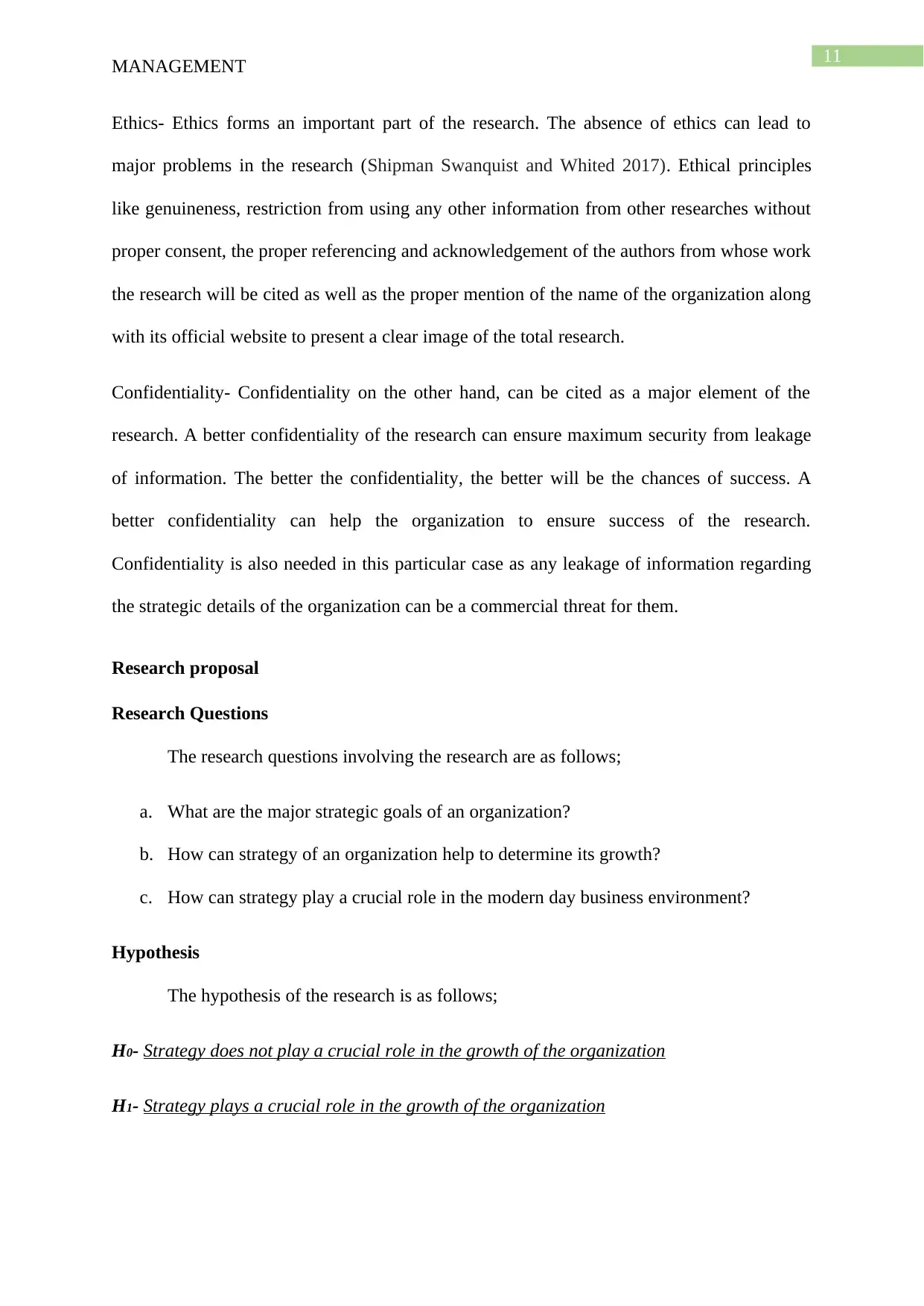
11
MANAGEMENT
Ethics- Ethics forms an important part of the research. The absence of ethics can lead to
major problems in the research (Shipman Swanquist and Whited 2017). Ethical principles
like genuineness, restriction from using any other information from other researches without
proper consent, the proper referencing and acknowledgement of the authors from whose work
the research will be cited as well as the proper mention of the name of the organization along
with its official website to present a clear image of the total research.
Confidentiality- Confidentiality on the other hand, can be cited as a major element of the
research. A better confidentiality of the research can ensure maximum security from leakage
of information. The better the confidentiality, the better will be the chances of success. A
better confidentiality can help the organization to ensure success of the research.
Confidentiality is also needed in this particular case as any leakage of information regarding
the strategic details of the organization can be a commercial threat for them.
Research proposal
Research Questions
The research questions involving the research are as follows;
a. What are the major strategic goals of an organization?
b. How can strategy of an organization help to determine its growth?
c. How can strategy play a crucial role in the modern day business environment?
Hypothesis
The hypothesis of the research is as follows;
H0- Strategy does not play a crucial role in the growth of the organization
H1- Strategy plays a crucial role in the growth of the organization
MANAGEMENT
Ethics- Ethics forms an important part of the research. The absence of ethics can lead to
major problems in the research (Shipman Swanquist and Whited 2017). Ethical principles
like genuineness, restriction from using any other information from other researches without
proper consent, the proper referencing and acknowledgement of the authors from whose work
the research will be cited as well as the proper mention of the name of the organization along
with its official website to present a clear image of the total research.
Confidentiality- Confidentiality on the other hand, can be cited as a major element of the
research. A better confidentiality of the research can ensure maximum security from leakage
of information. The better the confidentiality, the better will be the chances of success. A
better confidentiality can help the organization to ensure success of the research.
Confidentiality is also needed in this particular case as any leakage of information regarding
the strategic details of the organization can be a commercial threat for them.
Research proposal
Research Questions
The research questions involving the research are as follows;
a. What are the major strategic goals of an organization?
b. How can strategy of an organization help to determine its growth?
c. How can strategy play a crucial role in the modern day business environment?
Hypothesis
The hypothesis of the research is as follows;
H0- Strategy does not play a crucial role in the growth of the organization
H1- Strategy plays a crucial role in the growth of the organization
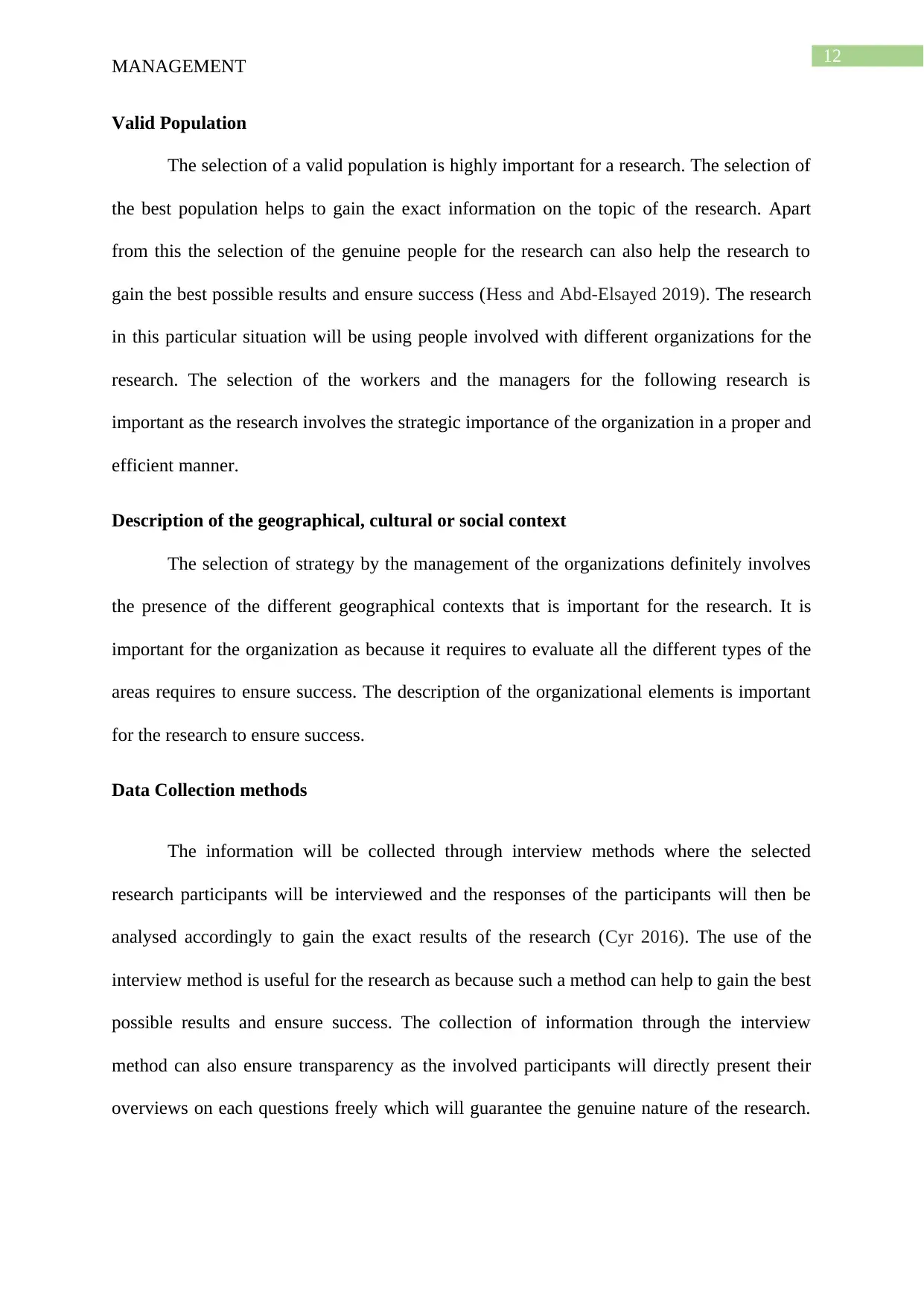
12
MANAGEMENT
Valid Population
The selection of a valid population is highly important for a research. The selection of
the best population helps to gain the exact information on the topic of the research. Apart
from this the selection of the genuine people for the research can also help the research to
gain the best possible results and ensure success (Hess and Abd-Elsayed 2019). The research
in this particular situation will be using people involved with different organizations for the
research. The selection of the workers and the managers for the following research is
important as the research involves the strategic importance of the organization in a proper and
efficient manner.
Description of the geographical, cultural or social context
The selection of strategy by the management of the organizations definitely involves
the presence of the different geographical contexts that is important for the research. It is
important for the organization as because it requires to evaluate all the different types of the
areas requires to ensure success. The description of the organizational elements is important
for the research to ensure success.
Data Collection methods
The information will be collected through interview methods where the selected
research participants will be interviewed and the responses of the participants will then be
analysed accordingly to gain the exact results of the research (Cyr 2016). The use of the
interview method is useful for the research as because such a method can help to gain the best
possible results and ensure success. The collection of information through the interview
method can also ensure transparency as the involved participants will directly present their
overviews on each questions freely which will guarantee the genuine nature of the research.
MANAGEMENT
Valid Population
The selection of a valid population is highly important for a research. The selection of
the best population helps to gain the exact information on the topic of the research. Apart
from this the selection of the genuine people for the research can also help the research to
gain the best possible results and ensure success (Hess and Abd-Elsayed 2019). The research
in this particular situation will be using people involved with different organizations for the
research. The selection of the workers and the managers for the following research is
important as the research involves the strategic importance of the organization in a proper and
efficient manner.
Description of the geographical, cultural or social context
The selection of strategy by the management of the organizations definitely involves
the presence of the different geographical contexts that is important for the research. It is
important for the organization as because it requires to evaluate all the different types of the
areas requires to ensure success. The description of the organizational elements is important
for the research to ensure success.
Data Collection methods
The information will be collected through interview methods where the selected
research participants will be interviewed and the responses of the participants will then be
analysed accordingly to gain the exact results of the research (Cyr 2016). The use of the
interview method is useful for the research as because such a method can help to gain the best
possible results and ensure success. The collection of information through the interview
method can also ensure transparency as the involved participants will directly present their
overviews on each questions freely which will guarantee the genuine nature of the research.
⊘ This is a preview!⊘
Do you want full access?
Subscribe today to unlock all pages.

Trusted by 1+ million students worldwide
1 out of 22
Related Documents
Your All-in-One AI-Powered Toolkit for Academic Success.
+13062052269
info@desklib.com
Available 24*7 on WhatsApp / Email
![[object Object]](/_next/static/media/star-bottom.7253800d.svg)
Unlock your academic potential
Copyright © 2020–2025 A2Z Services. All Rights Reserved. Developed and managed by ZUCOL.




